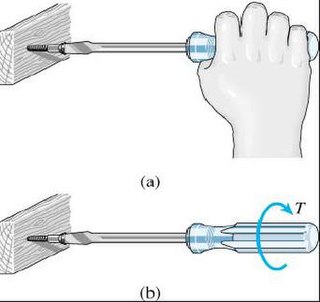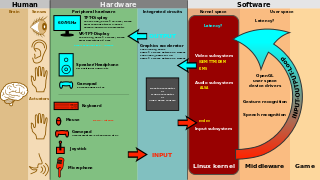Related Research Articles
The Session Initiation Protocol (SIP) is a signaling protocol used for initiating, maintaining, and terminating communication sessions that include voice, video and messaging applications. SIP is used in Internet telephony, in private IP telephone systems, as well as mobile phone calling over LTE (VoLTE).
Usability testing is a technique used in user-centered interaction design to evaluate a product by testing it on users. This can be seen as an irreplaceable usability practice, since it gives direct input on how real users use the system. It is more concerned with the design intuitiveness of the product and tested with users who have no prior exposure to it. Such testing is paramount to the success of an end product as a fully functioning application that creates confusion amongst its users will not last for long. This is in contrast with usability inspection methods where experts use different methods to evaluate a user interface without involving users.
Usability engineering is a field that is concerned generally with human–computer interaction and specifically with devising human–computer interfaces that have high usability or user friendliness. It provides structured methods for achieving efficiency and elegance in interface design.
A think-aloudprotocol is a method used to gather data in usability testing in product design and development, in psychology and a range of social sciences.

Usability can be described as the capacity of a system to provide a condition for its users to perform the tasks safely, effectively, and efficiently while enjoying the experience. In software engineering, usability is the degree to which a software can be used by specified consumers to achieve quantified objectives with effectiveness, efficiency, and satisfaction in a quantified context of use.

The vestibulo-ocular reflex (VOR) is a reflex acting to stabilize gaze during head movement, with eye movement due to activation of the vestibular system. The reflex acts to stabilize images on the retinas of the eye during head movement. Gaze is held steadily on a location by producing eye movements in the direction opposite that of head movement. For example, when the head moves to the right, the eyes move to the left, meaning the image a person sees stays the same even though the head has turned. Since slight head movement is present all the time, VOR is necessary for stabilizing vision: people with an impaired reflex find it difficult to read using print, because the eyes do not stabilise during small head tremors, and also because damage to reflex can cause nystagmus.

Banner blindness is a phenomenon in web usability where visitors to a website consciously or unconsciously ignore banner-like information. A broader term covering all forms of advertising is ad blindness, and the mass of banners that people ignore is called banner noise.
Eye tracking is the process of measuring either the point of gaze or the motion of an eye relative to the head. An eye tracker is a device for measuring eye positions and eye movement. Eye trackers are used in research on the visual system, in psychology, in psycholinguistics, marketing, as an input device for human-computer interaction, and in product design. In addition, eye trackers are increasingly being used for assistive and rehabilitative applications such as controlling wheelchairs, robotic arms, and prostheses. There are several methods for measuring eye movement, with the most popular variant using video images to extract eye position. Other methods use search coils or are based on the electrooculogram.

Electronystagmography (ENG) is a diagnostic test to record involuntary movements of the eye caused by a condition known as nystagmus. It can also be used to diagnose the cause of vertigo, dizziness or balance dysfunction by testing the vestibular system. Electronystagmography is used to assess voluntary and involuntary eye movements. It evaluates the cochlear nerve and the oculomotor nerve. The ENG can be used to determine the origin of various eye and ear disorders.

User interface (UI) design or user interface engineering is the design of user interfaces for machines and software, such as computers, home appliances, mobile devices, and other electronic devices, with the focus on maximizing usability and the user experience. In computer or software design, user interface (UI) design primarily focuses on information architecture. It is the process of building interfaces that clearly communicates to the user what's important. UI design refers to graphical user interfaces and other forms of interface design. The goal of user interface design is to make the user's interaction as simple and efficient as possible, in terms of accomplishing user goals.
This is an alphabetical list of articles pertaining specifically to software engineering.

Supplementary eye field (SEF) is the name for the anatomical area of the dorsal medial frontal lobe of the primate cerebral cortex that is indirectly involved in the control of saccadic eye movements. Evidence for a supplementary eye field was first shown by Schlag, and Schlag-Rey. Current research strives to explore the SEF's contribution to visual search and its role in visual salience. The SEF constitutes together with the frontal eye fields (FEF), the intraparietal sulcus (IPS), and the superior colliculus (SC) one of the most important brain areas involved in the generation and control of eye movements, particularly in the direction contralateral to their location. Its precise function is not yet fully known. Neural recordings in the SEF show signals related to both vision and saccades somewhat like the frontal eye fields and superior colliculus, but currently most investigators think that the SEF has a special role in high level aspects of saccade control, like complex spatial transformations, learned transformations, and executive cognitive functions.
Protocol analysis is a psychological research method that elicits verbal reports from research participants. Protocol analysis is used to study thinking in cognitive psychology, cognitive science, and behavior analysis. It has found further application in the design of surveys and interviews, usability testing, educational psychology and design research. With the introduction of video- and audio-based based surveys, the scale and scope of verbal report collection is increased dramatically compared to in-person verbal report recording.
The pluralistic walkthrough is a usability inspection method used to identify usability issues in a piece of software or website in an effort to create a maximally usable human-computer interface. The method centers on recruiting a group of users, developers and usability professionals to step through a task scenario, discussing usability issues associated with dialog elements involved in the scenario steps. The group of experts used is asked to assume the role of typical users in the testing. The method is prized for its ability to be utilized at the earliest design stages, enabling the resolution of usability issues quickly and early in the design process. The method also allows for the detection of a greater number of usability problems to be found at one time due to the interaction of multiple types of participants. This type of usability inspection method has the additional objective of increasing developers’ sensitivity to users’ concerns about the product design.
Usability testing methods aim to evaluate the ease of use of a software product by its users. As existing methods are subjective and open to interpretation, scholars have been studying the efficacy of each method and their adequacy to different subjects, comparing which one may be the most appropriate in fields like e-learning, e-commerce, or mobile applications.

In software engineering, rubber duck debugging is a method of debugging code by articulating a problem in spoken or written natural language. The name is a reference to a story in the book The Pragmatic Programmer in which a programmer would carry around a rubber duck and debug their code by forcing themselves to explain it, line by line, to the duck. Many other terms exist for this technique, often involving different (usually) inanimate objects, or pets such as a dog or a cat. Teddy bears are also widely used.
LabelTag can create a circular label on the data side of any DVD+R, DVD-R, or CD-R disc containing basic information visible to the eye. When burning the data, the label is printed directly behind that data in the same recording session, and on normal recording speed on the same recording layer side. LabelTag works on any disc and does not require a special disc like LightScribe. Currently, LabelTag is an exclusive technology of Lite-On for its DVD writer drives.
Partial concurrent thinking aloud is a method used to gather data in usability testing with screen reader users. It is a particular kind of think aloud protocol created by Stefano Federici and Simone Borsci at the Interuniversity Center for Research on Cognitive Processing in Natural and Artificial Systems of University of Rome "La Sapienza". The partial concurrent thinking aloud is built up in order to create a specific usability assessment technique for blind users, eligible to maintain the advantages of concurrent and retrospective thinking aloud while overcoming their limits. Using PCTA blind users' verbalizations of problems could be more pertinent and comparable to those given by sighted people who use a concurrent protocol. In the usability evaluation with blind people, the retrospective thinking aloud is often adopted as a functional solution to overcome the structural interference due to thinking aloud and hearing the screen reader imposed by the classic thinking aloud technique; such a solution has yet a relapse in the evaluation method, because the concurrent and the retrospective protocols measure usability from different points of view, one mediated by navigation experience (retrospective) one more direct and pertinent (concurrent). The use of PCTA could be widened to both summative and formative usability evaluations with mixed panels of users, thus extending the number of problems' verbalizations according to disabled users' divergent navigation processes and problem solving strategies.
User experience evaluation (UXE) or user experience assessment (UXA) refers to a collection of methods, skills and tools utilized to uncover how a person perceives a system before, during and after interacting with it. It is non-trivial to assess user experience since user experience is subjective, context-dependent and dynamic over time. For a UXA study to be successful, the researcher has to select the right dimensions, constructs, and methods and target the research for the specific area of interest such as game, transportation, mobile, etc.

The Latin New Car Assessment Programme is an automobile safety assessment programme for Latin America and the Caribbean. Founded in 2010, it offers independent information to consumers about the safety levels of new cars in the market. Latin NCAP tests are based in international renowned methodologies, with vehicles awarded a safety rating between 0 and 5 stars, indicating the protection the cars offer to adult and child occupants. The programme started as a joint initiative and in 2014 it was established as an association under a legal entity framework.
References
- "The Validity of the Stimulated Retrospective Think-Aloud Method as Measured by Eye Tracking". 2006. CiteSeerX 10.1.1.95.8504 .
- "Using Retrospective Think Aloud With Eye Tracking Usability Testing". 24 September 2009.